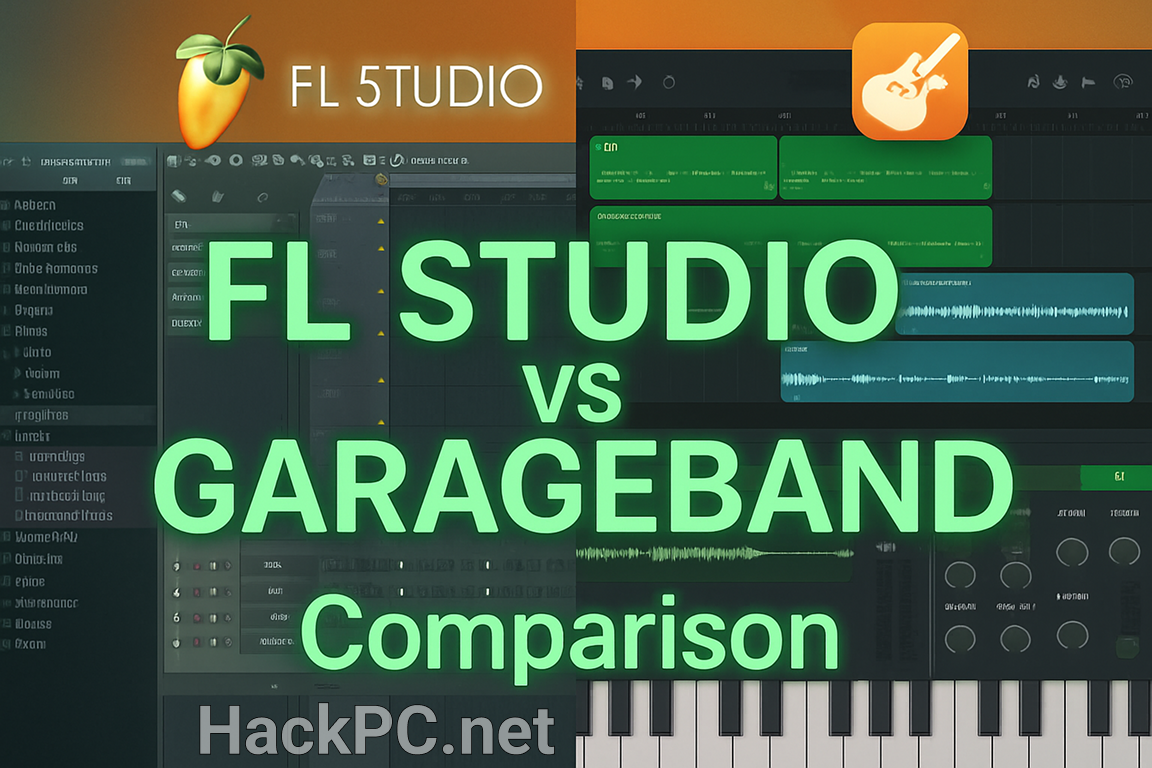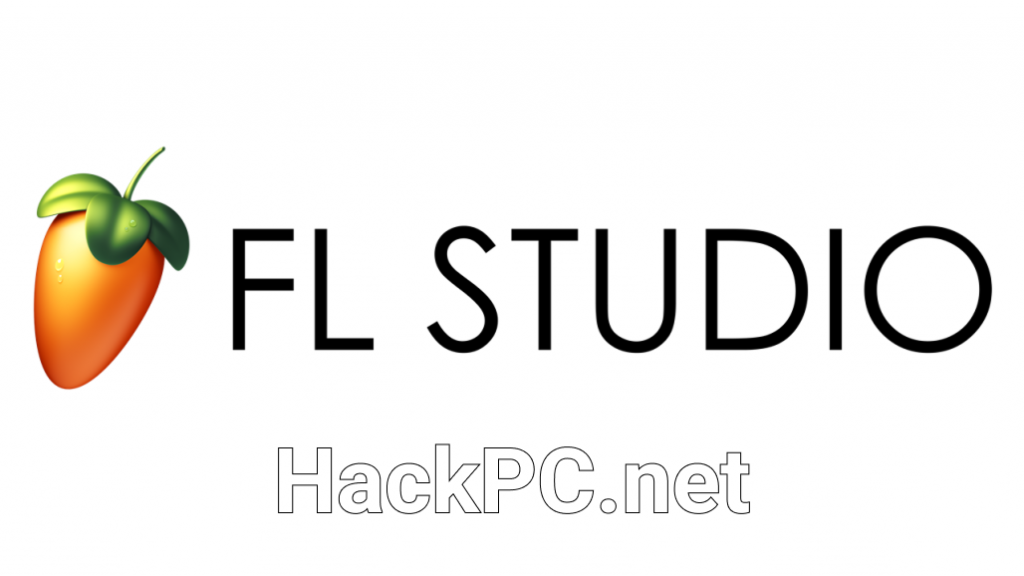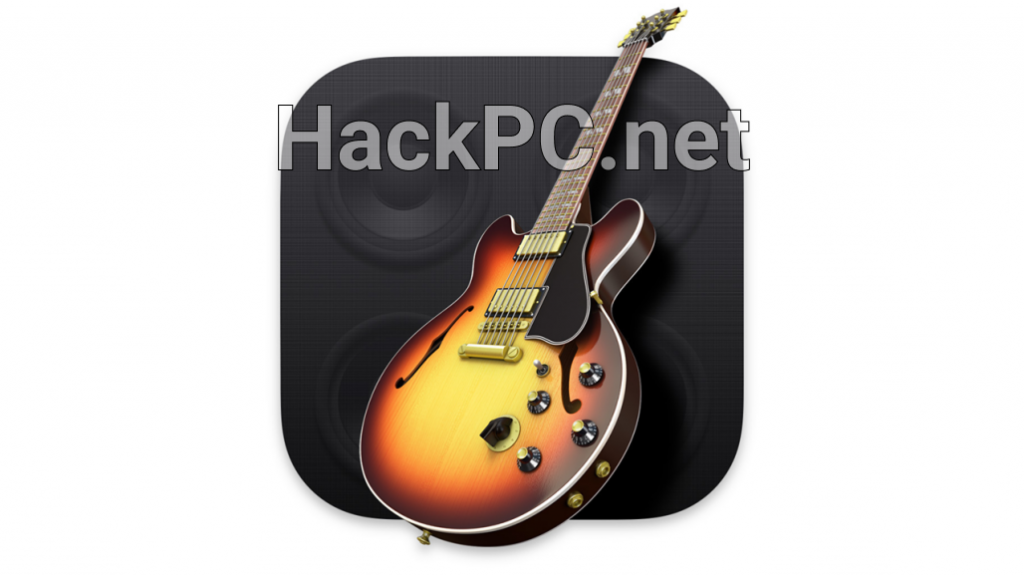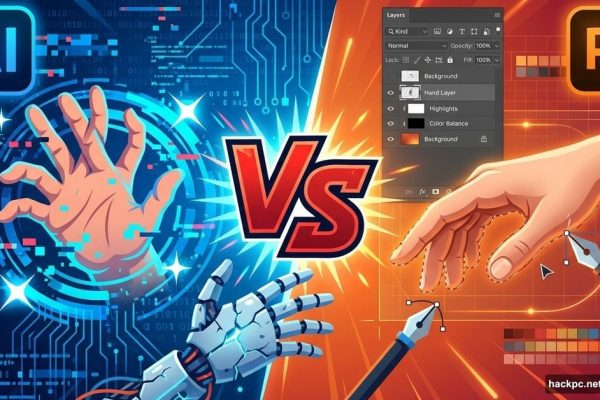
Picture this: You’re standing at a crossroads in your music production journey, wallet in one hand, creative ambitions in the other. Two paths diverge before you — one leading to Image-Line’s FL Studio, the other to Apple’s GarageBand. Which digital audio workstation deserves your time, energy, and potentially your money?
After spending countless hours immersed in both platforms through various production projects, I’ve discovered that this comparison isn’t just about features — it’s about understanding which tool aligns with your creative workflow and musical aspirations. FL Studio 2025 maintains its legendary lifetime free updates policy while introducing game-changing features like 500 mixer tracks and AI-powered assistance, while GarageBand continues to offer professional-grade capabilities completely free for Mac users.
Platform Availability and System Requirements: The First Divide
Let’s address the elephant in the room immediately. GarageBand is exclusively available for Mac, iPhone, and iPad users, coming pre-installed on Apple devices. Meanwhile, FL Studio runs on both Windows and Mac platforms, though some users report the Mac version isn’t quite as polished as its Windows counterpart.
This fundamental difference shapes everything else about these music production software choices. If you’re working on a Windows machine, FL Studio becomes your only option between the two. However, Mac users face the luxury problem of choosing between both digital audio workstations, each with distinct advantages for home studio setups.
The system requirements tell another story. GarageBand requires macOS 14.4 or later for the latest version. FL Studio’s requirements are more flexible, running on older systems while still delivering professional audio production capabilities. This flexibility makes FL Studio particularly attractive for producers working with varied hardware configurations or those building budget-conscious music creation setups.

Pricing Models: Free Forever vs. Pay Once, Update Forever
Here’s where things get interesting for budget-conscious music creators. GarageBand remains completely free for all Apple users, positioning itself as a highly cost-effective solution for aspiring musicians and producers. You get the full software, no restrictions, no trial periods — just download and start creating beats, recording vocals, or composing symphonies.
FL Studio takes a different approach with its tiered pricing structure. The software ranges from $99 for the Fruity Edition to $899 for the All Plugins Edition, but here’s the kicker — you pay once and receive lifetime free updates, unlike competitors who charge $150-250 for major updates every few years. The Producer Edition at $199 hits the sweet spot for most users, offering comprehensive MIDI editing tools and audio recording capabilities.
FL Studio also offers FL Cloud as an optional subscription at £8.99 or £12.50 monthly, providing access to over a million royalty-free samples, third-party plugins, and integrated music distribution through DistroKid. However, the core DAW functionality remains perpetually yours after the initial purchase.
Interface Design and Workflow Philosophy
The moment you launch these programs, their philosophical differences become apparent. FL Studio’s sequencer-centric design makes it hard to tell where the sequencer ends and the DAW begins, creating a rhythmic bent exceptionally suited for electronic production styles like trap, hip-hop, and EDM.
FL Studio’s interface features multiple specialized windows — the Channel Rack for quick beat making, the Piano Roll for detailed MIDI sequencing, and the Playlist for arrangement. This modular approach offers incredible flexibility for electronic music producers who appreciate granular control over their creative process. The learning curve might seem steep initially, but the payoff comes in lightning-fast workflow once you’ve mastered the keyboard shortcuts and routing options.
GarageBand takes the opposite approach with its streamlined, single-window interface. The software’s intuitive design features a timeline view resembling a traditional multitrack recorder, making it immediately accessible for beginners while offering sufficient depth for intermediate producers. Smart Controls provide quick parameter access without overwhelming new users with options.
GarageBand’s Live Loops feature enables real-time music creation and remixing, particularly useful for performers and those who prefer a more spontaneous approach to beat production. This feature transforms your computer into an intuitive music-making instrument rather than just a recording platform.
The Great Feature Face-Off: Core Capabilities
Track Count and Mixer Capabilities
FL Studio 2025’s headline feature is its Dynamic Mixer Tracks system, supporting up to 500 insert tracks — a massive upgrade from the previous 125-track limitation. This expansion proves invaluable for complex orchestral arrangements, layered electronic productions, or anyone who refuses to bounce tracks down during the creative process.
GarageBand supports up to 255 tracks, which honestly exceeds most home studio project requirements. Unless you’re scoring films or creating exceptionally dense arrangements, you’ll rarely hit this ceiling.
MIDI Editing and Sequencing Power
FL Studio’s Piano Roll stands as the gold standard for MIDI editing software. Widely considered the best in the industry for composing complex melodies and arranging MIDI data, it offers unparalleled precision for note editing, velocity curves, and automation. The ghost note feature, scale highlighting, and chord stamp tools transform MIDI programming from tedious work into creative exploration.
GarageBand offers both Piano Roll and Score Editor views, with the latter allowing musicians to work with traditional notation — something FL Studio lacks. While GarageBand includes quantization, articulation, and automation features comparable to FL Studio, FL Studio’s workflow controls enable significantly faster creation, particularly for electronic music patterns.
Built-in Instruments and Effects
Both DAWs ship with impressive sound libraries and virtual instruments, though their approaches differ significantly. GarageBand’s extensive library includes professionally recorded instruments, approximately 2,800 loops, and sounds curated by industry professionals through regular updates. The Drummer track feature deserves special mention — it’s like having a virtual session drummer who actually understands musical dynamics and song structure.
FL Studio counters with its comprehensive synthesis options and electronic-focused instruments. The inclusion of Sytrus, Harmor, and other advanced synthesizers provides sound design capabilities that push well beyond GarageBand’s offerings. For electronic music producers and sound designers, FL Studio’s native plugins deliver professional results without requiring third-party VST investments.
Audio Recording and Editing
GarageBand simplifies audio recording with its support for 24-bit recording and straightforward editing tools, perfect for singer-songwriters and band recordings. The software excels at traditional recording scenarios — plug in your guitar or microphone, hit record, and you’re capturing professional-quality audio.
FL Studio includes advanced audio editing through Edison and Newtone, providing pitch correction and time manipulation capabilities that surpass GarageBand’s basic editing functions. However, FL Studio’s recording setup requires more configuration and isn’t quite as intuitive as GarageBand’s plug-and-play approach.
The AI Revolution: Smart Features for Modern Producers
FL Studio 2025 introduces Gopher, an AI assistant trained on FL Studio’s manual and knowledge base, capable of answering production questions in natural language directly within the DAW. This feature represents the beginning of AI-integrated music production, helping new users navigate FL Studio’s complexity while assisting experienced producers with advanced techniques.
Loop Starter, another FL Studio 2025 innovation, provides instant genre-based loop stacks, eliminating the blank project paralysis that plagues many producers. Combined with the new Emphasis mastering plugin for release-ready processing, these features accelerate the journey from initial idea to finished track.
GarageBand’s smart features focus on accessibility and ease of use. Musical Typing transforms your computer keyboard into a playable instrument, while Smart Controls automatically map essential parameters for quick adjustments. The software’s built-in lessons, including artist-taught sessions, provide educational value that FL Studio doesn’t match.
Professional Capabilities and Industry Recognition
Let’s address a common question: Can these DAWs produce professional, commercial-quality music? Absolutely, but with caveats.
FL Studio boasts an impressive roster of successful users across genres. Major electronic producers, hip-hop beatmakers, and even film composers have created chart-topping hits entirely within FL Studio. The software provides professional-grade tools at an affordable price, making high-quality production accessible to independent artists.
GarageBand, despite its consumer-friendly positioning, has been used to create professional recordings, though it’s rarely the primary DAW for commercial studios. Many producers view GarageBand as a sketchpad for ideas later refined in Logic Pro X or other professional platforms. The seamless project transfer between GarageBand and Logic Pro makes this workflow particularly attractive for Apple ecosystem users.
Professional producers note FL Studio’s extensive VST plugin support enables integration of industry-standard third-party instruments and effects, while GarageBand’s limited plugin support can restrict creative possibilities for advanced users.
Collaboration and Remote Production Features
Neither FL Studio nor GarageBand offers native real-time collaboration features, requiring manual file sharing for remote teamwork. However, their approaches to collaboration differ significantly.
GarageBand’s integration with iCloud, AirDrop, and other Apple services makes project sharing between Apple devices remarkably smooth. You can start a beat on your iPhone during your commute and finish it on your Mac at home — this ecosystem integration remains unmatched.
FL Studio’s cross-platform compatibility means collaborators aren’t locked into specific hardware, though file sharing requires more manual coordination. The software’s project file format (.flp) maintains complete session data, ensuring nothing gets lost in translation between collaborators.
Learning Curves and Community Support
The learning curve comparison reveals interesting contrasts. GarageBand’s gentle introduction to music production makes it ideal for absolute beginners. Within minutes, you’re laying down tracks and experimenting with sounds. The simplified interface means fewer features to master but also fewer advanced techniques available when you’re ready to level up.
FL Studio’s learning curve resembles a steep mountain with a spectacular view at the summit. Initial setup and understanding can take several hours, but once you grasp the workflow, it becomes remarkably intuitive. FL Studio’s extensive community provides numerous tutorials and forums, beneficial for learning, while GarageBand has fewer resources for users seeking advanced techniques.
Performance and System Optimization
GarageBand operates at a fixed 44.1 kHz sample rate with no buffer size adjustment options, while FL Studio supports up to 192 kHz with customizable buffer settings. For audiophiles and mixing engineers requiring maximum fidelity, FL Studio’s flexibility proves crucial.
However, GarageBand’s fixed settings mean less troubleshooting and configuration. The software just works, utilizing Apple’s hardware-software integration for optimal performance. FL Studio users often spend time optimizing settings for their specific hardware configurations — a double-edged sword offering control at the cost of simplicity.
Some users report GarageBand’s CPU usage can spike with heavy projects, causing lag or crashes on less powerful machines. FL Studio generally handles large projects more efficiently, though this varies depending on your specific plugins and workflow.
Mobile Integration and Cross-Device Workflows
GarageBand’s iOS integration exemplifies intuitive mobile music creation, allowing users to leverage the portability of iPhones and iPads for production anywhere. The touch interface feels natural for certain production tasks, and the ability to use your iPad as a control surface for the Mac version adds valuable flexibility.
FL Studio Mobile exists as a separate purchase, offering surprising depth for mobile production but lacking the seamless integration of GarageBand’s ecosystem. Project compatibility between FL Studio desktop and mobile versions continues improving but doesn’t match GarageBand’s effortless synchronization.
The Verdict: Choosing Your Digital Audio Workstation
After extensive analysis, here’s my take on which music production software suits different user profiles:
Choose GarageBand if you:
- Own Apple devices exclusively
- Want to start making music immediately without financial investment
- Prefer intuitive interfaces over feature depth
- Value seamless integration across devices
- Focus on singer-songwriter or band recording
- Plan to eventually upgrade to Logic Pro X
Choose FL Studio if you:
- Need cross-platform compatibility
- Create electronic music, hip-hop, or beat-heavy genres
- Want the most powerful MIDI editing and sequencing tools available
- Appreciate lifetime free updates and long-term value
- Require extensive plugin support and customization options
- Don’t mind investing time to master a complex but rewarding workflow

Future-Proofing Your Choice
Looking ahead, both DAWs show strong development momentum. FL Studio 2025’s transition to year-based versioning signals Image-Line’s commitment to regular, substantial updates. The introduction of AI features and expanded track counts positions FL Studio at the forefront of modern music production technology.
Apple continues refining GarageBand with regular updates, though the pace of major feature additions has slowed compared to FL Studio. The software remains perfectly positioned as an entry point to music production, with Logic Pro X serving users who outgrow its capabilities.
Final Thoughts: Beyond the Binary Choice
The FL Studio versus GarageBand debate often misses a crucial point: these aren’t mutually exclusive choices. Many successful producers started with GarageBand’s approachable interface before graduating to FL Studio’s advanced capabilities. Others use GarageBand for quick idea capture while reserving FL Studio for detailed production work.
Your choice ultimately depends on your current needs, future ambitions, and available hardware. Both DAWs can produce professional-quality music in capable hands. The “best” choice is the one that inspires you to create, experiment, and push your musical boundaries.
Remember, legendary albums have been created with far less capable tools than either of these modern DAWs offers. Focus on developing your production skills, understanding music theory, and training your ears. The software is just a vehicle for your creativity — choose the one that feels like a natural extension of your musical vision, then master it completely.
Whether you’re crafting trap beats in FL Studio’s step sequencer or recording indie rock in GarageBand’s straightforward interface, the magic happens when technology disappears and only the music remains. Both these digital audio workstations excel at reaching that transcendent state where creative flow trumps technical considerations.
The revolution in affordable music production continues, and whether you choose FL Studio’s feature-rich ecosystem or GarageBand’s elegant simplicity, you’re entering an era where bedroom producers compete with million-dollar studios. The question isn’t which DAW is objectively better — it’s which one empowers you to tell your unique musical story.



Comments (0)